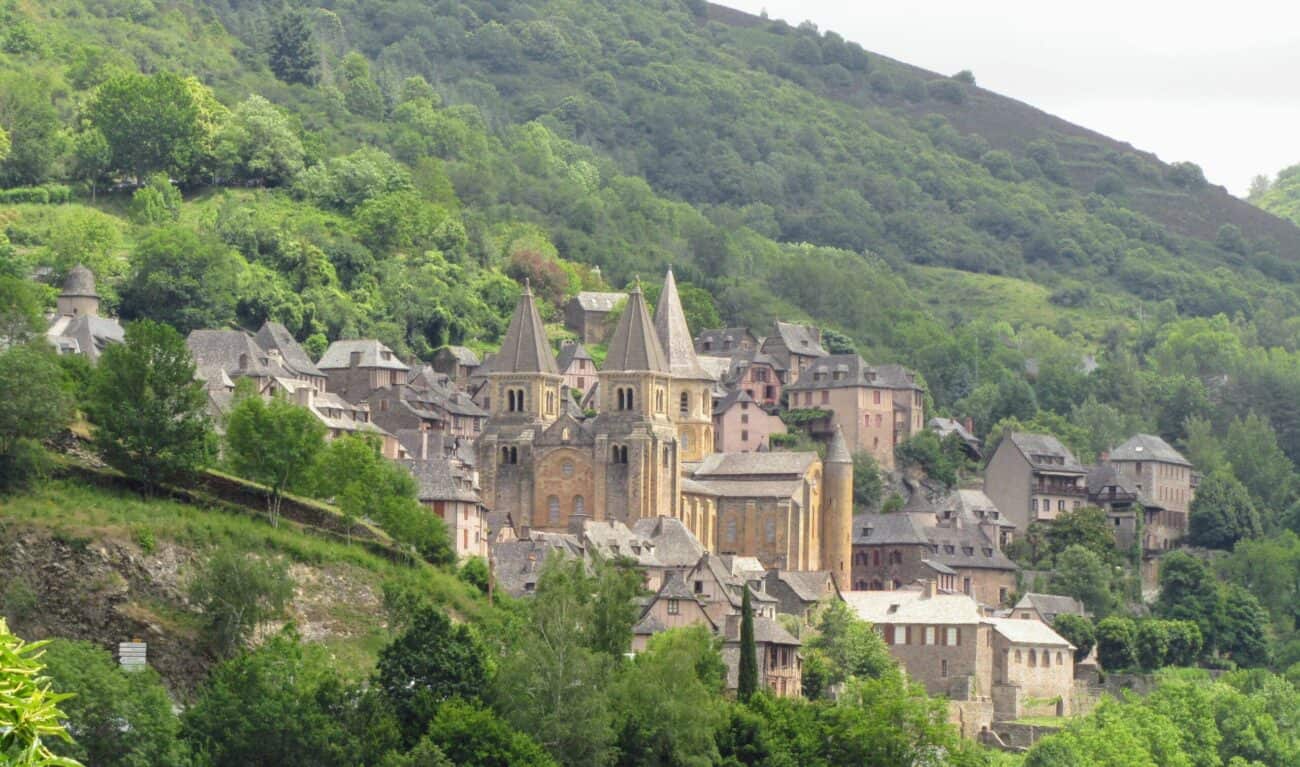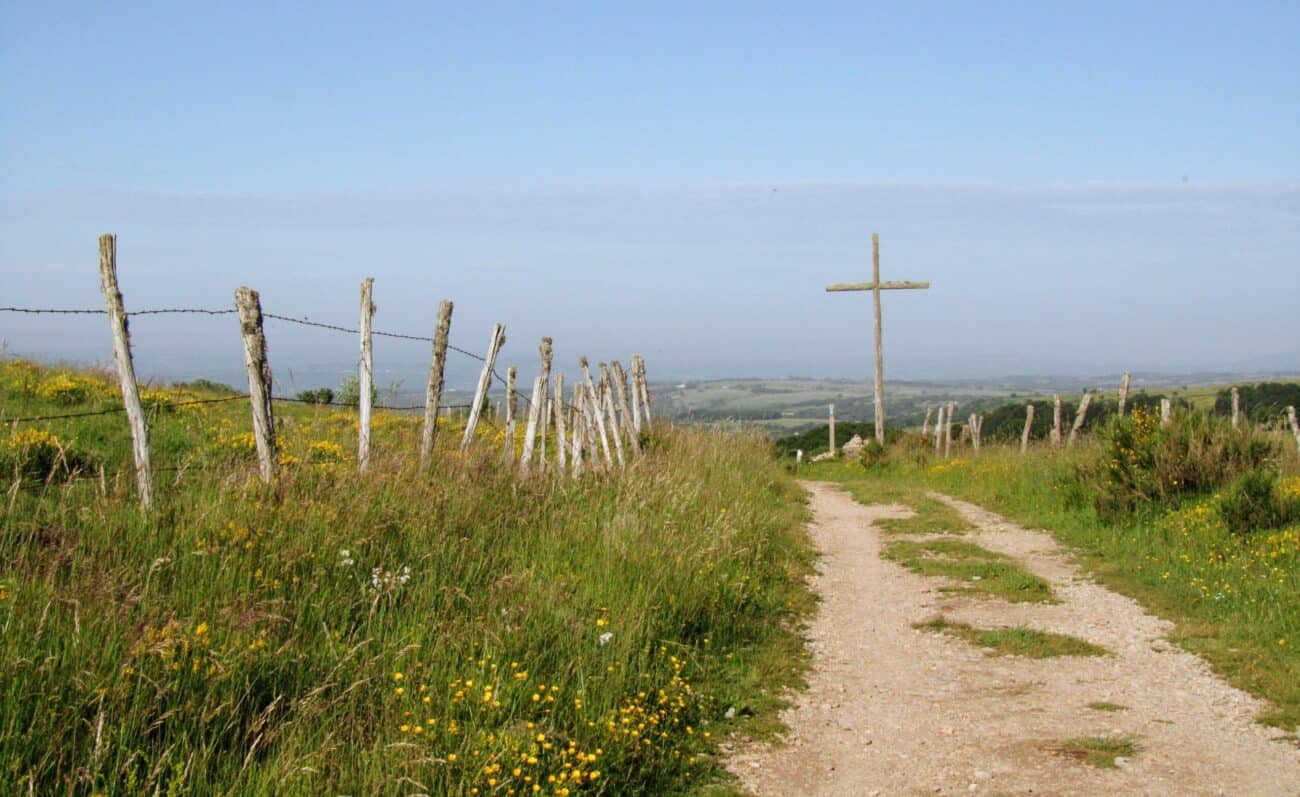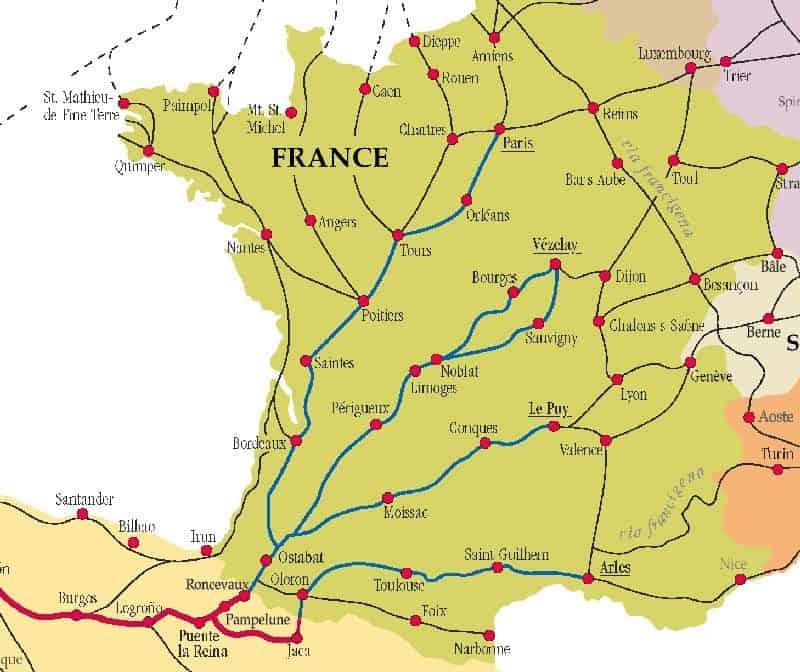There are four main Camino routes in France.
- Camino Le Puy or Via Podiensis
- Paris and Tours Way or Via Turonensis
- The Vézelay Route or Via Lemovicensis
- The Arles Route or Via Tolasana
The routes in France are not referred to as Camino de Santiago in France but as Chemin Saint Jacques. The only route I have walked is Le Puy Route.
France has always been the favored starting point for Camino pilgrims. Back when Santiago de Compostela was little known about, most pilgrims were French, and the path they walked came to be known amongst the Spanish as “The French road.”
Today, pilgrims can choose from one of the four main Camino de Santiago routes in France that join the Camino de Santiago routes in Spain to get to Santiago in Spain. The routes leave from different cities and pass through significant religious places, giving them distinct characteristics that are uniquely their own.
Camino Le Puy or Via Podiensis

The Le Puy Route also called Le Chemin du Puy or Via Podiensis. This route starts in Le Puy en Velay and joins with two other routes in France at Ostabat near St Jean Pied de Port which they pass through and continue along the Camino Frances to Santiago.
The route is fairly tough going and quite hilly, it is harder than the Camino Frances and, at 736 km, is nearly as long. The waymarking on the route is the GR65 signs, with very few Camino signs.
Le Puy or Via Podiensis offers the best views amongst all Caminos in France, and it’s also the shortest. For these reasons, its immense popularity among pilgrims shouldn’t surprise you. The route starts in the scenic town of Le Puy-en-Valey and goes through several towns before it reaches the French-Spanish border at Saint-Jean-Pied-de-Port.
The terrain is variable but rarely flat and can be exhausting for people who aren’t used to hiking. The route goes through many ascents and descents in the Velay region, then travels uphill to the Aubrac Plateau at the height of 1,300 meters above sea level.
The trail starts to ease up from this mountainous region and descends to Conques. You will pass by a series of limestone scrublands called causses, Cahors, some farmlands, Moissac, and then finally reach the Basque Country.
The route is known for its natural panoramas and the many historical monuments dotted along the way. Every town or village you stop over will have an old abbey, church, or cathedral that is worth visiting.
Paris and Tours Way or Via Turonensis
The Paris Camino Route is also known as the Chemin de Paris, Via Turonensis, or The Tours Way. (the last really describes the route from Tours). That is quite a few designations for a route that is not very popular at present and is said to still being re-built in parts. Like all of the routes in France, this one also follows a GR, the GR655. The route is about 1,000km to St Jean. Currently, the distances are not exact.
As the most northerly route, Paris and Tours or Via Turonensis was traditionally used by pilgrims from the Low Countries and those living in northern and western Europe. Not many pilgrims travel this way, and despite starting in a touristy city, it is the least known of the Camino routes in France. However, it is slowly gaining popularity now that other French routes are becoming busier.
The route is described to start from Tour St. Jacques in the Pilgrim’s Guide, but most modern pilgrims begin anywhere. Many set off from Chartres. Others take a detour to Orléans, which leads across the Loire Valley and Tours and converges with the road from Chartres. From there, the route heads southwest through Poitou, Saintonge, Bordeaux, and Les Landes, where it once again merges with two of the four main Camino routes in France, Le Puy, and Vézelay.
Paris and Tours span for 913/1,000 kilometers, and it takes nearly two months to walk if rest and sightseeing are included. Pilgrims are encouraged to create their own routes since the old footpath no longer exists and has been replaced with major roads. This route’s main advantage is the opportunity to explore Paris before the pilgrimage.
The Vézelay Route or Via Lemovicensis
The Vezelay Camino Route is also known as the Chemin de Vezelay or the Via Lemovicensis, the Latin name. Again joins the above two routes just before St Jean and continues along the Camino Frances. The distance to St Jean is about 900km. Most of the route follows the GR654, but there have been efforts to re-create the original route by associations in France.
Pilgrims coming from northern and eastern Europe have traveled this way since the Middle Ages, making it one of the oldest Camino de Santiago routes. It was originally called Via Lemovicensis since it goes through Limoges, a city valued for its history and culture. The route begins in the town of Vézelay in Burgundy, where a pilgrimage to Mary Magdalene can also be found. From here, the main route branches out into the Bourges and Nevers.
The Bourges route is shorter and easier to walk. Its path is more consistently flat, but the sight of forests and farmlands tends to get boring. Only the Bourges Cathedral is worth paying a visit when passing by. Nevers route is longer and more challenging thanks to its varied terrain. If you choose to go this way, make a quick trip to the shrine of St. Bernadette Soubirous.
The two routes converge and continue on to Limousin, Périgord, Aquitaine, and the Landes. Once you reach GR 65 near Ostabat, the Vezélay joins two more routes from France, Tours, and le Puy-en-Velay. The entire route is about 900 km long and covers a wide array of landscapes, including hills, valleys, mountains, forests, farmlands, and vineyards. It also passes several historical landmarks. To reach Santiago, you would have to travel another 800 km via Camino de Francés from St. Jean Pied-de-Port.
The Arles Route or Via Tolasana
The Arles Camino Route is also known as Via Tolasana or Chemin d’Arles. This route has its own association that is working hard to look after the route; I met a couple of them on the Le Puy route. This is the one main route that does not go to St Jean but joins the Camino Aragones and then joins the Camino Frances at Puente la Reina. This route follows the GR653.
Pilgrims have been walking the Arles Way since medieval times. It was a convenient route for Jacobean pilgrims since it was closest to south and east Europe. Back in its heyday, it was aptly called Via Tolosana as it passed by Toulouse, the most important city along the way.
Tradition tells us the route begins at Arles in Provence, but you can start your pilgrimage further at Montpellier in Languedoc. As you travel westwards, you will come across the sharp hills of Haut-Laguedoc. The way becomes easier from Toulouse to Oloron-Saint-Marie as the road becomes flatter and leads through lower hills and an open plateau. The trail continues southwards to Aspe Valley and crosses the Pyrenees to reach Aragón on the border of Spain.
The entire route is 800 km long on the French side. The Arles Route is extremely varied and physically demanding, but it is also the most isolated path for those yearning for a peaceful walk. Much like the Le Puy Way, there will be plenty of historical attractions, including the church and abbey of Saint-Gilles-du-Gard, the basilica of Saint Sernin in Toulouse, and Canal du Midi in Montferrand. Attractive and picturesque villages such as Saint-Guilhem-le-Désert and Revel can likewise be expected.
If ever you decide to go on The Way of St. James via France, you can never go wrong with Le Puy, Vézelay, Arles, and Tours. The four main Camino routes in France may be lengthy and challenging for most people. But they pay off with stunning landscapes, religious architecture, and other historical monuments. Various accommodations are available along these routes, and a decent selection of places to eat local cuisine.
There are many other routes in France, most of them are feeder routes to the above, and the others in themselves can be very long. If you are interested in similar hikes, there are many alternatives to Camino de Santiago.

I love hiking, backpacking, and camping. From the Camino de Santiago to the West Highland Way in Scotland or simply a great day hike on the weekend. Hiking refreshes me, my mind, and keeps my body reasonably fit. So far I have walked three Camino routes and many other long distance hikes in the UK, Canada, and around the rest of Europe. One of the best was my hike up Ben Nevis.


